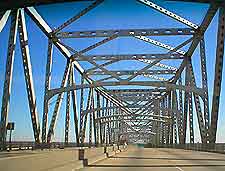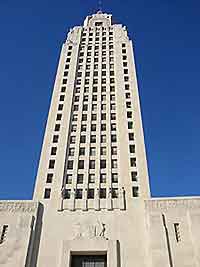Baton Rouge History Facts and Timeline
(Baton Rouge, Louisiana - LA, USA)

Located on the first upriver bluff north of the Mississippi River Delta, the settlement of Baton Rouge - now a large city, is protected from flooding, hurricanes and natural disasters by its carefully chosen position. Just in case, however, the city's lower-lying agricultural acres and riverfront are nestled safely behind a series of levees which stretch southward from the conurbation itself.
Prior to the end of the 17th century, the Baton Rouge region had served as hunting grounds split between several Indian nations, with excavations suggesting hunter-gatherer communities had been using the area since 4500 BC.
European Settlement
The history of Baton Rouge might not have begun were it not for the efforts of the early European settlers, who showed an interest in Native American Indian tradition.
The first to arrive were French explorer Sieur d'Iberville and his party in 1699. Settlement progressed slowly until the tiny town was incorporated in 1817, along with its population of Cajun descendants of the Acadians, exiled from
Canada in 1755. The name Baton Rouge was coined from red cypress poles festooned with blood and animal skins, spotted on the banks of the Mississippi river.
Steamboats and Civil War
Baton Rouge was adopted as the state capital of Louisiana in 1849, having survived the American War of Independence relatively unscathed, and having made the most of the waterway and the invention of the steamboat to boost its economy.
Economic progress for its 5,500 residents, however, was interrupted by the outbreak of the Civil War in 1861. Union forces occupied the town in 1862 while the Confederate Army's back was turned in another direction. Attempts by the Confederates to reoccupy the city came to nothing, with Baton Rouge firmly in Union hands until the war ended in 1865.

A 'Quaint Old Place'
In 1893, a casual observer described the city as a 'quaint old place' with 10,000 inhabitants, set on a bluff above the Mississippi, and so it was, with Baton Rouge history calmly continuing to unfold and troubling no one. Still the seat of the Louisiana government, in spite of a brief transfer of power to
New Orleans in the reconstruction period following the Civil War, Baton Rouge was mainly supported economically by its steamboat trade and related commercial enterprises. All this, however, was about to change.
Black Gold
In 1906, the thrust of Baton Rouge's laid-back history and economic dependency on the river was changed forever by the discovery of oil and natural gas in northern Louisiana, followed by a 'black gold' rush of land-leasing, drilling and the construction of natural gas pipelines. Here began the earliest commercial use of natural gas, which was previously just burnt off at the site of the well. Before long, the city was a hive of industrial and petrochemical activity, with the river still playing its part as a major deep-water port.
Modernity in Baton Rouge
The boom in petrochemical products in the 1950s and '60s sparked a related boom in housing and yet more commercial construction, with new industries such as pharmaceutics and research emerging. In the 21st century, technology is the buzzword in this fast-growing conurbation.
The still visible heritage and history of Baton Rouge and its vibrant multicultural peoples fully justifies the city motto - 'Authentic Louisiana at Every Turn'. Like its neighbor, New Orleans, the city took a hammering from Hurricane Katrina in 2005 and is still recovering.
 Located on the first upriver bluff north of the Mississippi River Delta, the settlement of Baton Rouge - now a large city, is protected from flooding, hurricanes and natural disasters by its carefully chosen position. Just in case, however, the city's lower-lying agricultural acres and riverfront are nestled safely behind a series of levees which stretch southward from the conurbation itself.
Located on the first upriver bluff north of the Mississippi River Delta, the settlement of Baton Rouge - now a large city, is protected from flooding, hurricanes and natural disasters by its carefully chosen position. Just in case, however, the city's lower-lying agricultural acres and riverfront are nestled safely behind a series of levees which stretch southward from the conurbation itself.